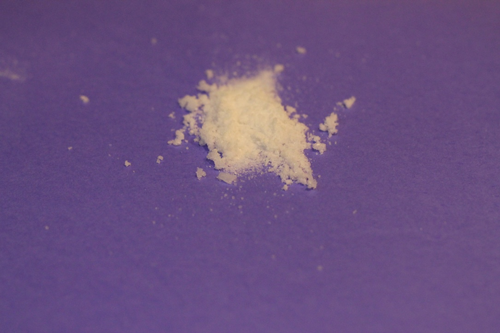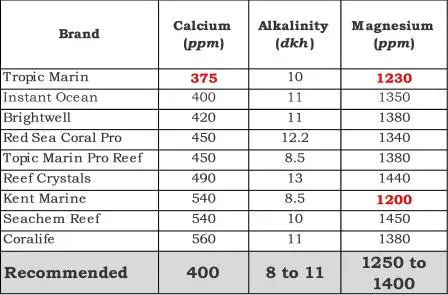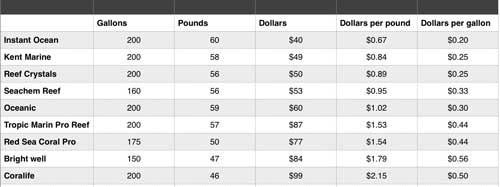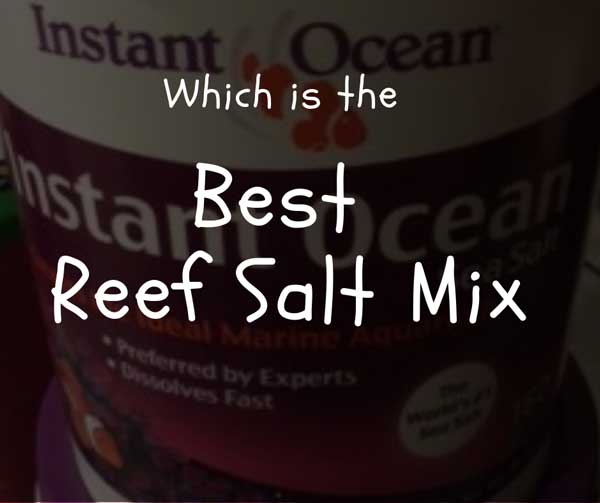The first time I walked through my local fish store to pick a salt mix for my tank, I was completely overwhelmed. There were pallets and pallets of different brand salt mixes. So I spent some time researching to find the best one and here is what I found.
The best reef salt mix will right blend of calcium, magnesium and trace elements in a precise ratio that will help you create the perfect environment for saltwater fish, corals and other invertebrates when properly mixed with freshwater. The industry standard is the Reef Crystals brand, by Instant Ocean.

See how the most popular brands stack up
To help decide which brand is actually the best, I started to compare the calcium, magnesium, and alkalinity levels, side by side. What’s the point of spending all that money on a salt mix, if I have to add a bunch of supplements just to get them into the right range.
As you can see from the chart below, the Reef Crystals Brand (which is what I use in my own tanks) stands out.
For me, of all the salts on the market, the best reef salt mix is Reef Crystals, by Instant Ocean. I will dive deeper into the comparisons in the following paragraphs.
The three most important aspects of a reef salt mix
Let’s start with an objective comparison across three important water parameters:
- calcium
- alkalinity
- magnesium


Calcium (Ca)
Calcium is a critically important component in ocean water (and the aquarium salt that we use to make that water). Ca is used by LPS corals like the Torch coral and other invertebrates in the tank to build their stony skeletons.

A typically recommended calcium level in a reef aquarium is 400 ppm. PPM stands for part per million, which in this case means 400 out of every million parts of the water will be calcium.
So it goes without saying (I guess I just said it though), that you should look carefully at the calcium levels in your desired salt mix.
Any brand with a level of around 400 ppm is good/ suitable. Significantly lower should be a red flag. Significantly higher is probably a good thing.
If you select a bargain salt with a low level of calcium, you’re going to have to spend additional time and money supplementing the water to get your desired levels. The other perspective of that point is that a salt mix with high levels of Ca is that you may not need to supplement your water to maintain appropriately high levels in your tank.
 Alkalinity (Alk)
Alkalinity (Alk)
The alkalinity of the mixture is another important feature to consider. Alk is also, unfortunately, a challenging concept to describe in simple terms. It’s a chemistry thing, related to the pH, or relative acidity of the water. Here is how it works. The scale is about comparing to ‘regular freshwater.

Almost by definition, pure water is not acidic or basic, but water with aquarium salts mixed in is considered to be relatively more basic or alkaline (it has more alkalinity). Alkalinity is important because it allows us to estimate how much bicarbonate is in the water–and bicarbonate is another one of those things that are important to coral growth, especially for LPS corals like Acans, Hammers, Favia, or Elegance corals, as well as SPS corals like Birds Nests, Acropora and Montipora.
The ideal range for alkalinity in a saltwater aquarium is 8-11 dkh. Which is a fairly broad range.
You would want to avoid a salt mix that makes your alkalinity too low or too high or is inconsistent between batches (which would cause the levels in your tank to swing back and forth.

Magnesium (Mg)
Magnesium is one of the most abundant of the ‘trace’ minerals in saltwater. It ‘works’ with calcium and impacts the balance of alkalinity in the aquarium water. The recommended range for magnesium in a healthy saltwater aquarium is ~1250 to 1400 ppm. Since magnesium is generally readily available in a high-quality salt mix, you just want to double-check and make sure that it is also abundant in the brand you choose…just so you know it is not something you generally need to worry about, in the best reef salt mix brands.
That doesn’t mean it isn’t important, just that you likely have it covered. Magnesium does become particularly important if you run into algae problems that you just can’t solve, like with Bryopsis, Hair algae or Cyanobacteria . Often times, those unsolvable problems are solved by raising the Magnesium.
How do the major aquarium salt brands stack up across these important parameters?
Several of the top aquarium salt brands are listed below, along with the values for calcium, alkalinity, and magnesium, as reported on their product labels. This list includes:
- Tropic Marin Salt Mix
- Instant Ocean Salt Mix
- Brightwell
- Red Sea Coral Pro
- Tropic Marin Pro Reef
- Reef Crystals Salt
- Kent Marine
- Seachem Reef Salt
- Coralife

The reported values of calcium, alkalinity, and magnesium are listed in the reef salt comparison chart, for each brand and the recommended range/value is included at the bottom. These are approximate values, not absolute. The first thing I noted was that all of the best marine salt mixes compared here post appropriate levels of each of the three water parameters: calcium, alkalinity, and magnesium
A few of the best reef salt mix options have standard ranges below the recommended levels. These are noted (in red). I don’t expect the fact that a few drifted slightly below my previously noted ideal range to be meaningful. I doubt there are any data, anywhere, to suggest those levels are demonstrably less effective than the rest of the mixes.
So while you may be inclined to make a decision based on that (and you might as well, you don’t have a lot of other information to go on), I also encourage you not to over-react in the event the salt you are currently using (or intended to use) is on the low end of the list here for any of these values.
A few conclusions about these top brands
- I would feel comfortable purchasing and using any of the above reef salt brand options for a tank with mushrooms, zoanthids, soft corals, LPS corals, or SPS corals
- If I observed an issue in my tank that I suspected of being related to a value…like alkalinity…for example. I might test out a higher alk salt to see if it helps and go either up or down on the scale to see if that makes a difference.
- If I was dosing one or more of those nutrients into my reef tank, and I knew how quickly my tank depleted those nutrients, I would use it as one additional factor in calculating the cost (or cost savings) of one salt versus another.

Comparing the costs of the best reef salt mix options
Since all of the major salt brands listed above have the most important water parameters covered, one could make an argument that there is no single best aquarium salt mix and that they are all pretty much the same (I suspect the marketing brand managers would cringe if they read that). One thing you can objectively compare is the cost (I probably made the marketing managers cringe for a second time there).
At first glance, however, it can be slightly challenging to compare the cost across salt brands, because the standard ‘bucket’ of salt can make 150, 160, 170, or even 200 gallons of salt water, depending on the manufacturer.
That makes the match nearly impossible for the average person (average dimwit writing this article, at your service). What I recommend you do to create a fair comparison is to take the price per bucket or box of salt and divide it by the number of gallons per container to determine the cost per gallon.
Here are a few hypothetical prices for each of the brands listed above that are approximated based on what I’ve seen. Please note, prices can fluctuate a bit online, so it’s typically best to go to the websites directly to do your own math and get the most accurate number. Below here is an example calculation based on some reasonable pricing estimates.

By creating the cost per gallon metric, it becomes a little easier to tell if the $77 bucket of Tropic Marin that makes 200 gallons is a relatively more or less expensive option than the $77 bucket of Red Sea Coral Pro salt that makes 175 gallons–or if the $40 boxes of Instant Ocean and Kent Marine Reef Salt are the same.
In the table above, I calculated the cost per pound of aquarium salt mix and the cost per gallon of mixed saltwater.
Factoring in the cost of adding supplements to your water
It wouldn’t be right to rule out a particular brand, just because they have a naturally lower concentration of a key element, because it is possible that you could add a supplement to the water mixed with that particular brand and achieve superior levels, at a better price–if the price is right.
Of course, the opposite is true as well.
For example, if you have a lot of stony corals (SPS or LPS) or clams, you may notice that the calcium levels in your tank steadily decline as the animals inside your tank deplete the natural calcium levels to build their stony skeletons and shells. In that instance, you probably want to supplement your aquarium water with a calcium reef supplement like kalkwasser (calcium hydroxide).

Those who regularly dose calcium in your tank, you would benefit from doing one further quick cost analysis when picking the best aquarium salt mix for your reef tank. So while my analysis above is just a straight cost per gallon, I encourage you to do your own math to figure out an ‘all-in’ cost per gallon once you account for supplements, if you add any.
If, for example, you buy Tropic Marin salt (at $0.39/gallon) and you routinely add calcium to your tank in the form of kalkwasser at an additional cost, it may be reasonable for you to consider switching to a brand like Seachem ($0.33/gallon), saving money and raising your calcium concentration by 165 parts per million–you may find you no longer need to add a calcium supplement between water changes, in that instance.

Why is Instant Ocean Reef Crystals salt mix the best?
Instant Ocean Salt is the best because it is a great quality product at a reasonable price. I realize that sounds straightforward, but that’s the type of person I am–and I put my money and my reef tank’s health where my mouth is.
Check out the prices on Amazon
Where to get more information about your specific reef aquarium salt mix
If you are interested in information beyond the scope of what is covered here in this review of the best reef salt mix, you may want to explore a few of the individual manufacturer sites for more information:
- Instant Ocean Salt
- Kent Marine Salt
- Seachem Reef Salt
- Coralife
- Tropic Marin Salt Mix
- Red Sea
- Brightwell
- Reef Crystals Salt
What reef salt mix do I use and where do I get it from?
I buy Instant Ocean Reef Crystals from Amazon.com (affiliate link).
No more lugging around buckets. The buckets come shipped directly to my door. No more drive time. No more hassle at all. And when the bucket arrives, I’m giddy, like a little kid on his birthday.
The product is Amazon Prime eligible (which means they will send it via 2-day shipping for free for Amazon Prime members) and also qualifies for their free Super Saver Shipping option too. What a great deal! You couldn’t beat that with an Acropora (get it? nickname..stick…).

If you decide to buy a bucket of salt or any other product on Amazon after clicking on one of the affiliate links above, I will earn a small commission. No pressure at all. You can find the same products, at the same prices by searching on your own, but thank you if you decide to use one of the links to make a purchase. Every little bit of support helps me continue to produce this website.
Looking for more product review info like this?
If you found this article helpful in simplifying some of the noise out there about what you should buy, check out these other helpful articles:
- Best protein skimmer
- Aquarium chiller product review
- Selecting the best aquarium heater
- Calcium reactor product review
- Most important reef tank parameters
- Phytoplankton growing
- Best reef aquarium test kits
What do you think?
How about you–what do you think is the best reef salt mix and why? Please leave a comment below to let us know what your experience is.
[author title=”About the Author”]



Leave a Reply